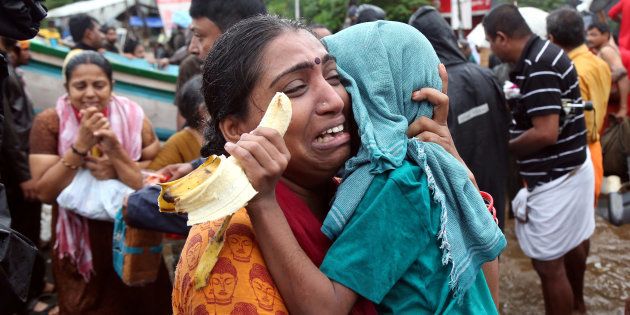
A rising chorus of voices on social media has been demanding that the Centre declare the Kerala floods a 'national disaster'. Led by Rahul Gandhi, various Twitter users have demanded that the government at the Centre declare the massive floods — which have claimed at least 357 lives and caused damage of Rs 19,000 crore — be called a 'national disaster', assuming that would make a difference to the allocation of funds and resources for relief to the state.
Chief Minister of Kerala, Pinarayi Vijayan had said, "Our demand is also the same. But the Centre is pointing out certain technical difficulties to make such an announcement."
On Monday, the Centre declared the Kerala floods a 'calamity of severe nature'. According to The Indian Express, declaring the Kerala floods a calamity of severe nature would mean the following:
— A calamity relief fund (CRF) will be set up and the Centre and state will bear the expenses at a 3:1 ratio.
— The state and the Centre will also consider concession in repayment of loans and could also extend fresh loans under flexible terms.
CAN THE FLOODS BE CALLED "NATIONAL DISASTER"?
According to a report on The Indian Express, there is no legal or executive provision to declare a 'natural calamity' as a national disaster.
The report added that the 2001 Gujarat earthquake, and the 1999 super cyclone in Odisha, were declared "a calamity of unprecedented severity" and treated as such by the government at the Centre. More than 13,000 people were killed in the Gujarat earthquake and the Odisha cyclone left at least 10,000 people dead.
Later, the flash floods in Uttarakhand and Himachal Pradesh, which took the lives of at least 4,094 people as per government records, were also not declared as a 'national disaster'.
The Disaster Management Act, 2005 puts down elaborate instructions about how the state and Centre should act and coordinate when a part of the country is faced with a severe natural calamity, but it says nothing about nomenclature of these calamities depending on the degree and extent of damage.
The Indian Expressreports that in 2001, the national committee on disaster management had tried to discuss the parameters by which a tragedy can be declared a 'national disaster', but nothing concrete came out of the meeting.
HOW ARE CALAMITIES CLASSIFIED IN INDIA?
The government has declared the Kerala floods to be a 'L3 level' disaster as specified by the national disaster management guidelines. In 1999, a committee headed by JC Pant recommended a series of guidelines on disaster management, including the formation of a ministry. However, these recommendations were not immediately implemented. Two years later, after the devastating Gujarat earthquake in 2001, the National Disaster Management Authority was formed under the Ministry of Home Affairs and it embraced several of the Pant committee's suggestions. L3 is the kind of disaster that demands the engagement of the state and centre and highest priority and maximum capacity.
"L1, L2, L3 levels of each type of disaster have to be predetermined, to lay out procedures to trigger off the Basic Initial Response Management Steps (BIRMS) without formal orders from any where. Sub-groups of ministries and departments which have been assigned responsibility of different sub-groups of disasters and so constituted at the national and state levels, have to address 3 this exercise at the earliest. L1 denotes a disaster which can be handled effectively at the district level. Normally L2 level of disasters of the district will be the L1 level at the state hqs; and L3 level of the district will be the L2 level of the state hqs; L3 level of the state hqs would normally be the L1 level at the centre. L0 level is designated as the preparatory level prior to L1. In disasters such as the Bhuj or J&K earthquakes or the Orissa super cyclone or the recent Tsunami L1, L2, L3 would perhaps be triggered off simultaneously," the Pant committee report said.
WILL DECLARING KERALA FLOODS 'NATIONAL CALAMITY' HELP?
According to this article on The Week, naming the calamity won't make any difference on paper. However, once the waters have receded and Kerala takes stock of the overall damage, the Centre is responsible for helping the state out wherever it falls short of funds.
Speaking to The Week, central government officials pointed out that if the Centre were to declare the floods a 'national disaster', it can release funds under the National Disaster Response Fund (NDRF) which is 100% borne by the Centre. The Centre has allocated Rs. 500 crore from the same fund for Kerala. The section of the disaster management act which talks about the national disaster response fund specifies that the amount to be disbursed solely depends on the Centre's appropriation of the situation.